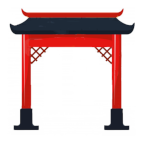| Meaning |

bent person 卩
|
| Explanation |
Shows a person 人 bowing down deeply. (Further radicals with "person" are: sitting 匕, sitting cross-legged 夂, lying  , kneeling ⺈, skilled 才, bending マ,卩, slumped 㔾 or husband 夫) , kneeling ⺈, skilled 才, bending マ,卩, slumped 㔾 or husband 夫)
|
Used in these characters:
|
|
服
|
 |
|
JLPT HSK 1 |
|
| clothes, dress, to take (medicine)
|
From left: body 月/肉, bent person 卩, hand 又
The (naked) body bends down with the hand for the clothes.

|
|
|
|
报
|
 |
|
JLPT HSK 2 |
|
| to announce, to inform, report, newspaper
|
Left: hand 扌, right: bent person 卩 and a further hand 又
About the bent person with two different hands was informed in an announcement.

|
|
|
|
脚
|
 |
|
JLPT HSK 3 |
|
| foot, leg, base
|
Left: body part 月/肉, right: retreat 却 (Leaving 去 in a bowed卩 position is a retreat.) [to leave 去 = Below ground 土 is the nose 厶 that has left.]
The body part for making a retreat [= leaving in a bowed position] is: the foot.

|
|
|
|
爷
|
 |
|
JLPT HSK 3 |
|
| grandfather, grandpa, old gentleman
|
Top: father 父 (.. has a stick ノ in his hand  ), bottom: bent person 卩 ), bottom: bent person 卩
This "father" is a bent person: The grandfather.

|
|
|
|
却
|
 |
|
JLPT HSK 4 |
|
| to retreat, to go back, but, yet
|
Left: to leave 去 (Below ground 土 is the nose 厶, which has left.), right: bowing person 卩
Leaving in a bowed position is a retreat.

|
|
|
|
即
|
 |
|
JLPT HSK 4 |
|
| immediate, prompt, namely, to approach
|
Left: simplification of "not good" 艮 ('good' would be 良, but here the accent 丶 is missing, thus 'not good'), right: bent person 卩
Not good, this person should bow down: Immediately!

|
|
|
|
印
|
 |
|
JLPT HSK 4 |
|
| a stamp, to mark, engrave, seal
yìn
卩
 |
|
Left: hand press  , right: bent person 卩 , right: bent person 卩
Under that press the bent person is stamped.

|
|
|
|
卫
|
 |
|
JLPT HSK 4 |
|
| to guard, protect, defend, hygiene
|
Image of work/worker 工 with a hanging arm
We only can use the worker with the hanging arm for: guarding.

|
|
|
|
御
|
 |
|
JLPT HSK 6 |
|
| to govern, to manage, imperial, defend, resist
|
Left: go 彳, right: unload 卸 (At noon 午 (during that heat) we can stop 止 and as we are bent 卩, we unload.)
I go at noon, stop and bow at the imperial, because I am governed.

|
|
|
|
卸
|
 |
|
JLPT HSK 6 |
|
| to unload, unhitch, remove or strip, get rid of
|
Left: noon 午, to stop 止, right: bowing person卩
At noon (during that heat) we can stop and as we are bent, we can unload.

|
|
|
|
抑
|
 |
|
JLPT HSK 6 |
|
| press down, restrain, restrict, suppress, or
|
Left: hand 扌, right: 卬 ([at the left] an odd person 人 bowing down 卩 deeply [at the right])
The hand that makes an 'odd' person to 'bow down deeply' is: repressing or restraining.

|
|
|
|
卿
|
 |
|
JLPT no HSK |
|
| high ranking official (old), honorific (old)
|
Outside: rabbit 卯 (Image of a rabbit's hole with a central passage and side chambers), inside: not good 艮 ('good' would be 良, but here the accent 丶 is missing, thus 'not good')
'You Rabbit!' is not good as an official honorific term.

|
|
|
|
叩
|
 |
|
JLPT no HSK |
|
| to knock, to kowtow
|
Left: mouth 口, right: bent person卩
The sound (= what comes out of the mouth) of a bent person is a knocking. (e.g. with the walking stick 丨 on the ground)

|
|
|
|
卵
|
 |
|
JLPT no HSK |
|
| egg, ovum, spawn
|
Similar to: rabbit 卯 (Image of a rabbit's hole with a central passage and side chambers)
Pictograph of eggs of fish or frog, which are aligned in a row.

|
|
|
|
唧
|
 |
|
JLPT no HSK |
|
| to splash, pump water, to whisper, to mutter
|
Left: mouth 口, right: immediate, prompt 即 (Not good 艮, this person should bow 卩 down, immediately!)
The mouth is not good, when during 'bowing down' sth. is: splashing out.

|
|
|
|
卯
|
 |
|
JLPT no HSK |
|
| 4th earthly branch: Rabbit, mortise (slot for wooden tenon)
|
Image of a rabbit's hole with a central passage and side chambers.

|
|
|
| Radicals are shown here that are similar either in appearance or meaning. |  |
|
At the page you get the memory phrases for learning the Chinese Hanzi. If you are learning the Japanese kanji, please follow this link. |
List of the characters |
List of the radicals
|

 , kneeling ⺈, skilled 才, bending マ,卩, slumped 㔾 or husband 夫)
, kneeling ⺈, skilled 才, bending マ,卩, slumped 㔾 or husband 夫)
 ), bottom: bent person 卩
), bottom: bent person 卩 , right: bent person 卩
, right: bent person 卩